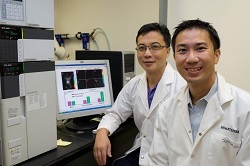 |
| Zhang Qichun and Joachim Loo |
Combining diagnostics and drug delivery is an ideal progression to improve the effectiveness and speed of treatment and a way to make drugs "smarter." To make one of these two-in-one systems, Singapore-based researchers developed a new biomarker that lights up to locate tumors and releases cancer drugs at the same time.
The scientists at Nanyang Technological University made the biomarker out of a nanophosphor particle which lights up when activated with a near-infrared light and in the presence of signaling molecules from tumor cells.
"Near-infrared light can penetrate 3 to 4 cm beyond the skin to deep tissue, much deeper than visible light. It also does not cause any damage to healthy cells, unlike ultraviolet or visible light," researcher Zhang Qichun said in a statement. "Visible light also causes photo bleaching, which is the destruction of the fluorescence dye that reduces the amount of time doctors and scientists have to image a tissue sample. Our new biomarker has effectively eliminated such key limitations which exist in existing biological markers."
The new biomarker can hold cancer drugs in an outside coating, which release when shone with the infrared light. It also boasts a higher contrast with three different colors of light, according to a release from the university, and is nontoxic, giving it the ability to stay in the body for up to two days at a time before passing.
"This is the first time we are able to do bio-imaging, and potentially target the delivery of drugs at the same time, as proven in small animal tests," said Joachim Loo, a nanotechnology and bioimaging expert. "Our breakthrough will open up new doors in the various fields of nanomedicine, bioimaging and cancer therapeutics."
The scientists published their early findings in the journal Small.
- here's the release